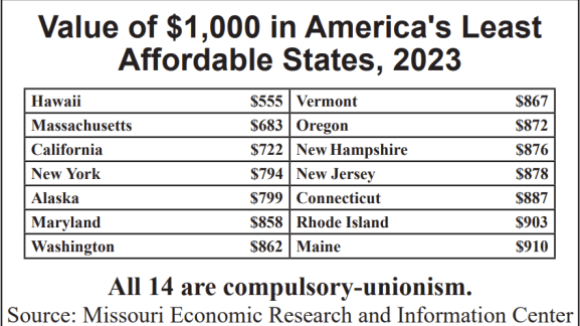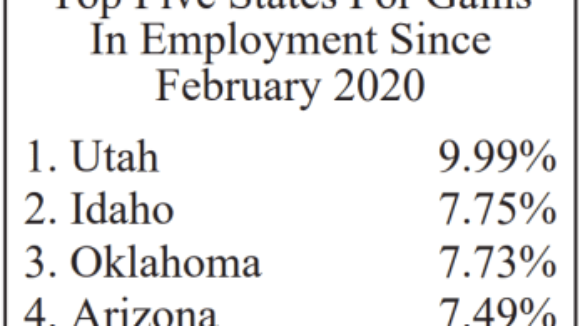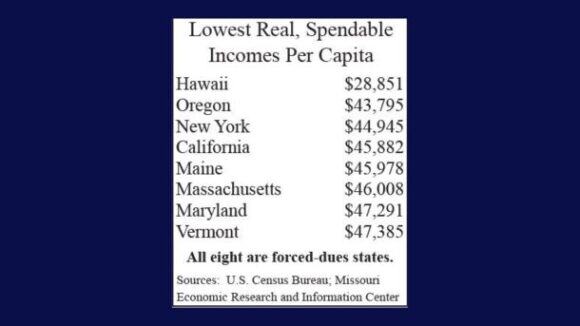Banning Compulsory Dues Curbs Cost of Living
On average, forced-unionism states are 23.2% more expensive to live in than Right to Work states. And decades of academic research show that compulsory unionism actually fosters a higher cost of living.
Andre Lacy, the Chairman of the Indiana Chamber of Commerce, weighs in on the need for Indiana to enact a Right to Work law:
Increasing Hoosier incomes is among our state’s greatest challenges. Indiana must compete globally for jobs and investment, building economic opportunity for our citizens. Key to achieving this goal and winning the competition for new jobs is the removal of self-imposed impediments. Adopting a right-to-work law will increase investment, incomes and economic opportunity for Hoosiers.
Lacy notes the overwhelming evidence that Right to Work is a benefit to workers and taxpayers:
. . . The effect on economic development and personal income is dramatic, well documented, and it contrasts sharply with those states – such as Indiana – that lack right-to-work laws.
The evidence is overwhelming.
In 2005, Colgate-Palmolive Co. decided to shutter its toothpaste factory in Clarksville and moved to a right-to-work state. In this instance, Indiana’s lack of a right-to-work law cost 475 Hoosiers their jobs and livelihoods.
Numerous studies show that personal income in right-to-work states grew almost twice as fast as that in non-RTW states between 2001 and 2006. During this same time, manufacturing in RTW states grew almost three times as fast as in non-RTW states. Growth in construction employment was also greater in those states with right-to-work laws.
In a 2002 study entitled “The Effect of Right-to-Work Laws on Economic Development,” economist William T. Wilson of the Mackinac Center for Public Policy compared Michigan’s economic performance to right-to-work states. Wilson found that during the 30 years between 1970 and 2000, RTW states created jobs nearly twice as fast as did Michigan. While poverty rates dropped dramatically during these 30 years, Michigan was one of seven states (all lacking right-to-work laws) that witnessed an increase in the percentage of residents living in poverty. Finally, the study showed that right-to-work states created 1.43 million manufacturing jobs, while non-right-to-work states lost 2.18 million manufacturing jobs during the same three decades.
Another 2002 study conducted for and published by the Federal Reserve Bank of St. Louis focused on the experience of Idaho (whose RTW law took effect in 1986) from 1987 through 2000. It concluded that Idaho experienced significant growth in investment and manufacturing employment after adopting right to work. Specifically, Idaho’s annual manufacturing “employment growth rate was about 3.7 percent post-law, compared with an almost zero annual average growth rate pre-law.”
Furthermore, the “growth rate in the number of establishments was about seven times larger compared with that in the pre-law period. Idaho did much better after the RTW law was passed, compared with most other states in the region, both in employment and in the number of establishments. . . . ”
Lacy’s conclusion is both obvious and correct:
. . . Adopting right-to-work will benefit two very broad groups of Hoosiers – workers and taxpayers. This reform will not be easy or without organized opposition. Doing so, however, will send a strong signal that Indiana is open for business and serious about increasing job opportunities for all Hoosiers.

On average, forced-unionism states are 23.2% more expensive to live in than Right to Work states. And decades of academic research show that compulsory unionism actually fosters a higher cost of living.

Strong employment gains in Right to Work states are the reason more Americans are working now than pre-COVID.

Where forced union dues are permitted, workers and other people end up with less purchasing power.